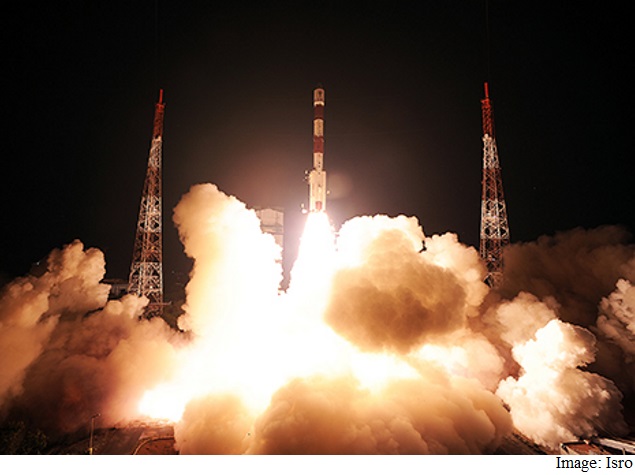- Home
- Science
- Science News
- 'Third Launch Pad Construction on Hold Until Long Term Space Plans Finalised'
'Third Launch Pad Construction on Hold Until Long-Term Space Plans Finalised'

"Our immediate focus is on completing the second vehicle (rocket) assembly. We can increase the rocket launch frequency after that. The decision to construct the third launch pad will be taken after finalising our long-term action plan," Indian Space Research Organisation (Isro) chairman A.S.Kiran Kumar told IANS.
At present Isro has two rockets - GSLV-MkII and Polar Satellite Launch Vehicle (PSLV) - and two launch pads at Sriharikota in Andhra Pradesh, around 80 km from here.
Queried about the need for a stand-by launch facility for Isro's heaviest rocket currently under development - the Geosynchronous Satellite Launch Vehicle-Mark III (GSLV-MkIII) - Kumar said: "The initial two GSLV-MkIII rockets will be flown using the second launch pad."
The GSLV-MkIII rocket is expected to be flight-ready in December 2016.
In a written reply to a question raised in the Rajya Sabha recently, Minister of State for Science and Technology Jitendra Singh said Isro proposes to set up the third launch pad at Satish Dhawan Space Centre (SDSC), Sriharikota.
He said the third launch pad is intended to support increased launch frequency, launching requirements of future advanced launch vehicles and also serve as a redundant launch pad for the GSLV-MkIII class of rockets.
Detailed studies on possible concepts/options and preliminary configuration have been carried out, he said.
The possible site for the third launch pad has been identified in Sriharikota taking into account the safety distances and maximal utilisation of existing launch pad facilities, he said.
"With plans to develop a much bigger rocket - GSLV-MkIII - and also taking into account the advanced future rockets, a need for a new launch pad was felt within Isro," SDSC director M.Y.S.Prasad told IANS on the phone.
"This apart, with Isro planning a manned mission in the future, the proposed launch pad should also have facilities that allow entry and exit of humans in and out of the rocket," he added.
When bigger and advanced rockets are being planned, the launch pad should also have necessary supporting infrastructure like huge fuel storage facilities for fuelling the rocket engines, Prasad said.
India's current rockets stand around 45-50 metres tall and the future rockets will be around 60-65 metres tall and much more heavier.
According to Prasad, a report on the third launch pad has been prepared by a study team with officials drawn from all the Isro centres.
The report has to be studied and a proposal for the third launch pad has to be submitted to the central government for funds.
Prasad said it would take around five years for the launch pad to come into service from the date of project approval and sanction of funds.
Apart from increasing the launch frequency of Indian satellites, the need for a new launch pad would also be considered, taking into account the opportunities for commercial launches - launching of third party satellites for a fee.
With Isro planning to fly its GSLV-MkIII rocket in 2016, a quicker decision on this project is important, officials said, adding that Isro might hire a consultancy firm to draw out the design as per requirements.
Prasad said the land area for the third launch pad and associated facilities will be around 3-4 sq km.
Meanwhile construction of the Rs. 360-crore second vehicle/rocket assembly building has begun at the SDSC.
"The building is expected to be ready in three years' time and would be connected to the second launch pad. As and when the third launch pad is ready, the new rocket assembly building will be connected to that as well," Prasad said.
Catch the latest from the Consumer Electronics Show on Gadgets 360, at our CES 2026 hub.
Related Stories
- Samsung Galaxy Unpacked 2025
- ChatGPT
- Redmi Note 14 Pro+
- iPhone 16
- Apple Vision Pro
- Oneplus 12
- OnePlus Nord CE 3 Lite 5G
- iPhone 13
- Xiaomi 14 Pro
- Oppo Find N3
- Tecno Spark Go (2023)
- Realme V30
- Best Phones Under 25000
- Samsung Galaxy S24 Series
- Cryptocurrency
- iQoo 12
- Samsung Galaxy S24 Ultra
- Giottus
- Samsung Galaxy Z Flip 5
- Apple 'Scary Fast'
- Housefull 5
- GoPro Hero 12 Black Review
- Invincible Season 2
- JioGlass
- HD Ready TV
- Laptop Under 50000
- Smartwatch Under 10000
- Latest Mobile Phones
- Compare Phones
- OPPO Reno 15 Pro Max
- Honor Win RT
- Honor Win
- Xiaomi 17 Ultra Leica Edition
- Xiaomi 17 Ultra
- Huawei Nova 15
- Huawei Nova 15 Pro
- Huawei Nova 15 Ultra
- Asus ProArt P16
- MacBook Pro 14-inch (M5, 2025)
- OPPO Pad Air 5
- Huawei MatePad 11.5 (2026)
- Xiaomi Watch 5
- Huawei Watch 10th Anniversary Edition
- Acerpure Nitro Z Series 100-inch QLED TV
- Samsung 43 Inch LED Ultra HD (4K) Smart TV (UA43UE81AFULXL)
- Asus ROG Ally
- Nintendo Switch Lite
- Haier 1.6 Ton 5 Star Inverter Split AC (HSU19G-MZAID5BN-INV)
- Haier 1.6 Ton 5 Star Inverter Split AC (HSU19G-MZAIM5BN-INV)

















